steering TOYOTA MATRIX 2013 E140 / 2.G Quick Reference Guide
[x] Cancel search | Manufacturer: TOYOTA, Model Year: 2013, Model line: MATRIX, Model: TOYOTA MATRIX 2013 E140 / 2.GPages: 28, PDF Size: 4.22 MB
Page 3 of 28
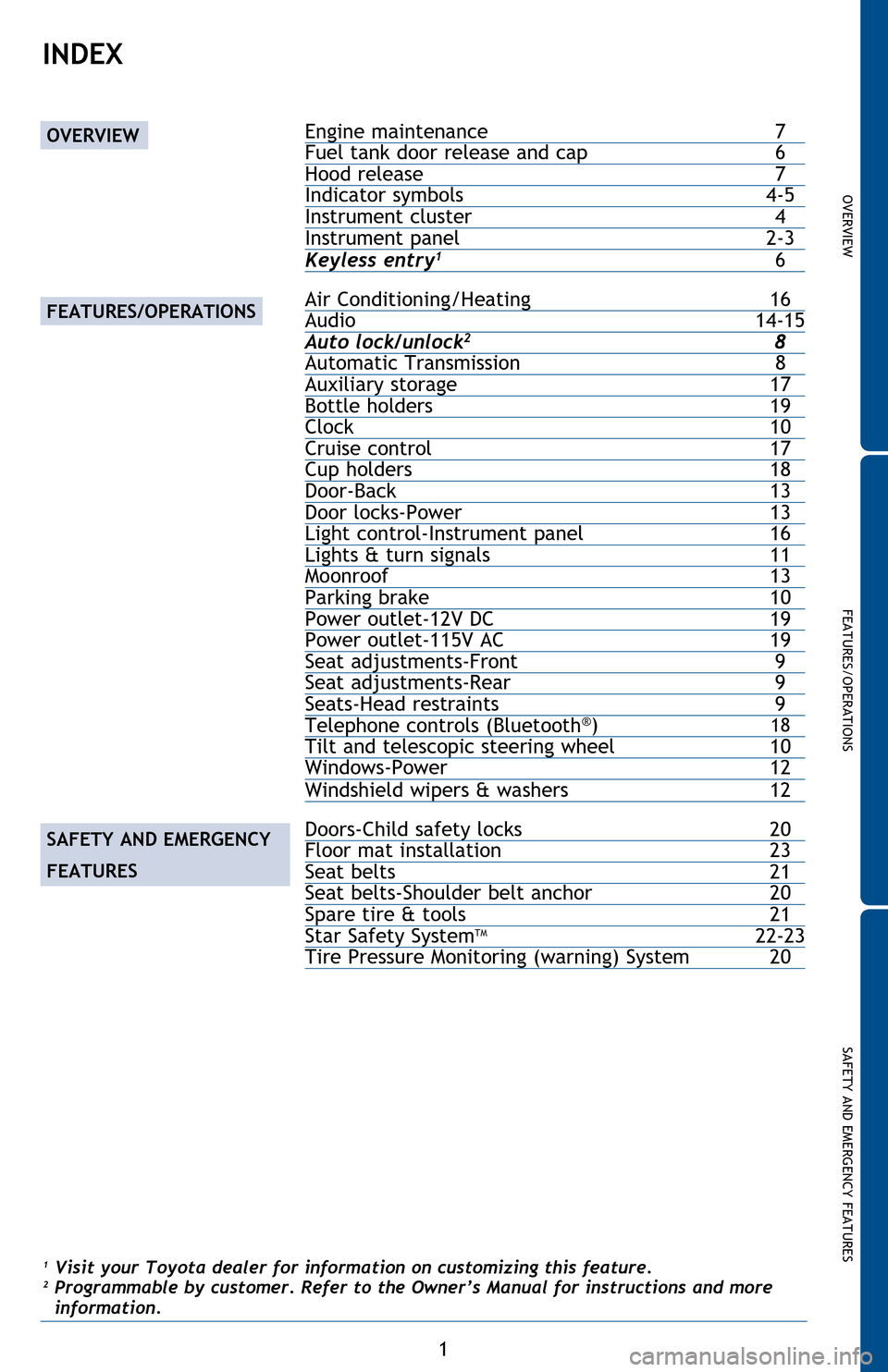
OVERVIEW
FEATURES/OPERATIONS
SAFETY AND EMERGENCY FEATURES
1
2013
Corolla Matrix
INDEX
Engine maintenance 7Fuel tank door release and cap 6Hood release 7Indicator symbols 4-5Instrument cluster 4Instrument panel 2-3Keyless entry1 6 Air Conditioning/Heating 16Audio 14-15Auto lock/unlock2 8Automatic Transmission 8Auxiliary storage 17Bottle holders 19Clock 10Cruise control 17Cup holders 18Door-Back 13Door locks-Power 13Light control-Instrument panel 16Lights & turn signals 11Moonroof 13Parking brake 10Power outlet-12V DC 19Power outlet-115V AC 19Seat adjustments-Front 9Seat adjustments-Rear 9Seats-Head restraints 9Telephone controls (Bluetooth®) 18Tilt and telescopic steering wheel 10Windows-Power 12Windshield wipers & washers 12 Doors-Child safety locks 20Floor mat installation 23Seat belts 21Seat belts-Shoulder belt anchor 20Spare tire & tools 21Star Safety SystemTM 22-23Tire Pressure Monitoring (warning) System 20
1 Visit your Toyota dealer for information on customizing this feature.2 Programmable by customer. Refer to the Owner’s Manual for instructions and more information.
OVERVIEW
FEATURES/OPERATIONS
SAFETY AND EMERGENCY
FEATURES
126923_2013Matrix.indd 17/21/12 1:36 AM
Page 4 of 28
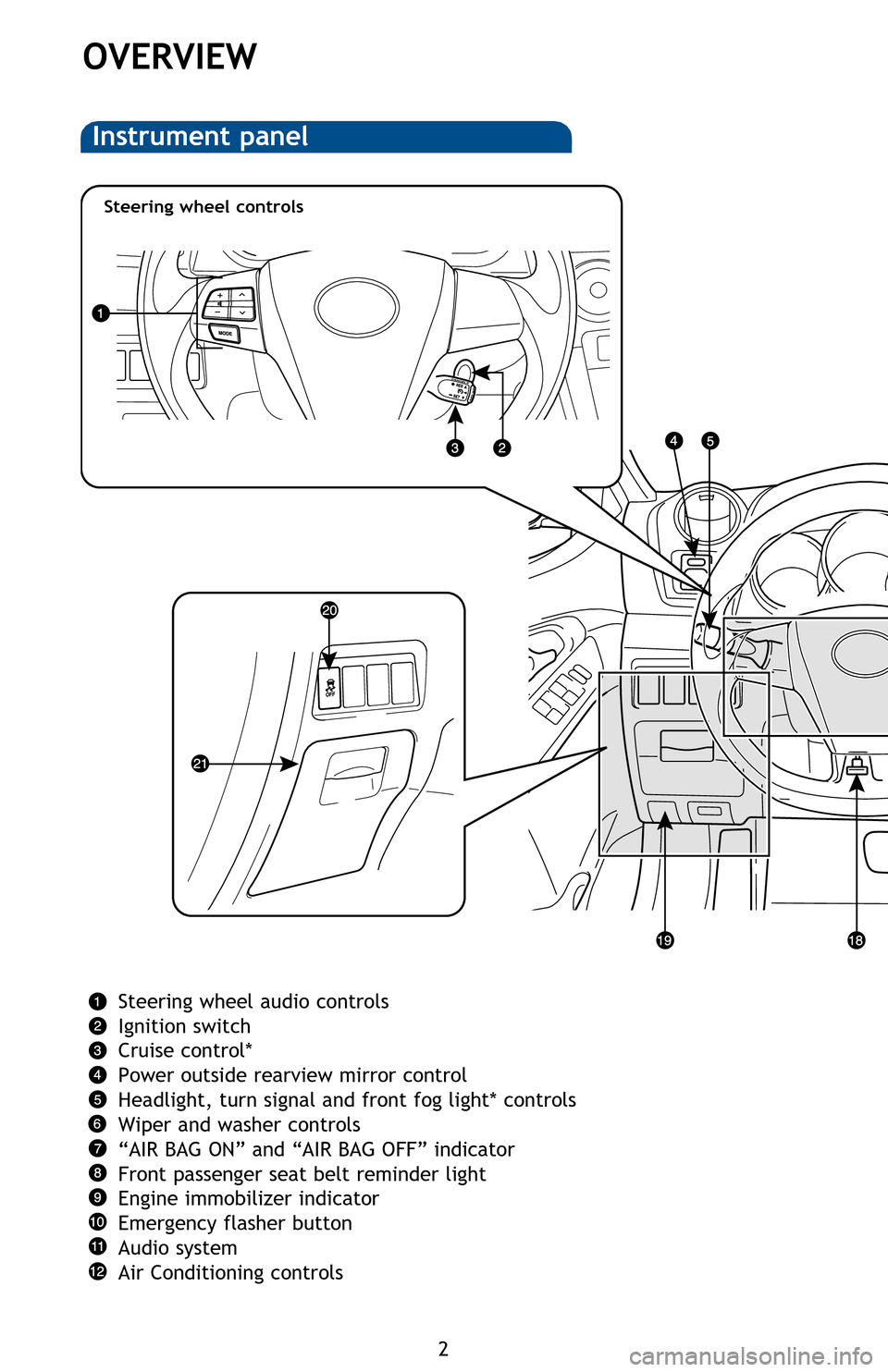
2
OVERVIEW
Instrument panel
Steering wheel audio controls
Ignition switch
Cruise control*
Power outside rearview mirror control
Headlight, turn signal and front fog light*
controls
Wiper and washer controls
“AIR BAG ON” and “AIR BAG OFF” indicator
Front passenger seat belt reminder light
Engine immobilizer indicator
Emergency flasher button
Audio system
Air Conditioning controls
Outside rearview mirrors*/Rear window defogger button
Power outlet (115V)*
AUX or AUX/USB port
Power outlet (12V) or cigarette lighter
Tire Pressure Monitoring (warning) System reset
Tilt and telescopic steering control
Hood lock release lever
VSC/TRAC OFF switch
Auxiliary storage
* If equipped
Steering wheel controls
126923_2013Matrix.indd 27/21/12 1:36 AM
Page 5 of 28
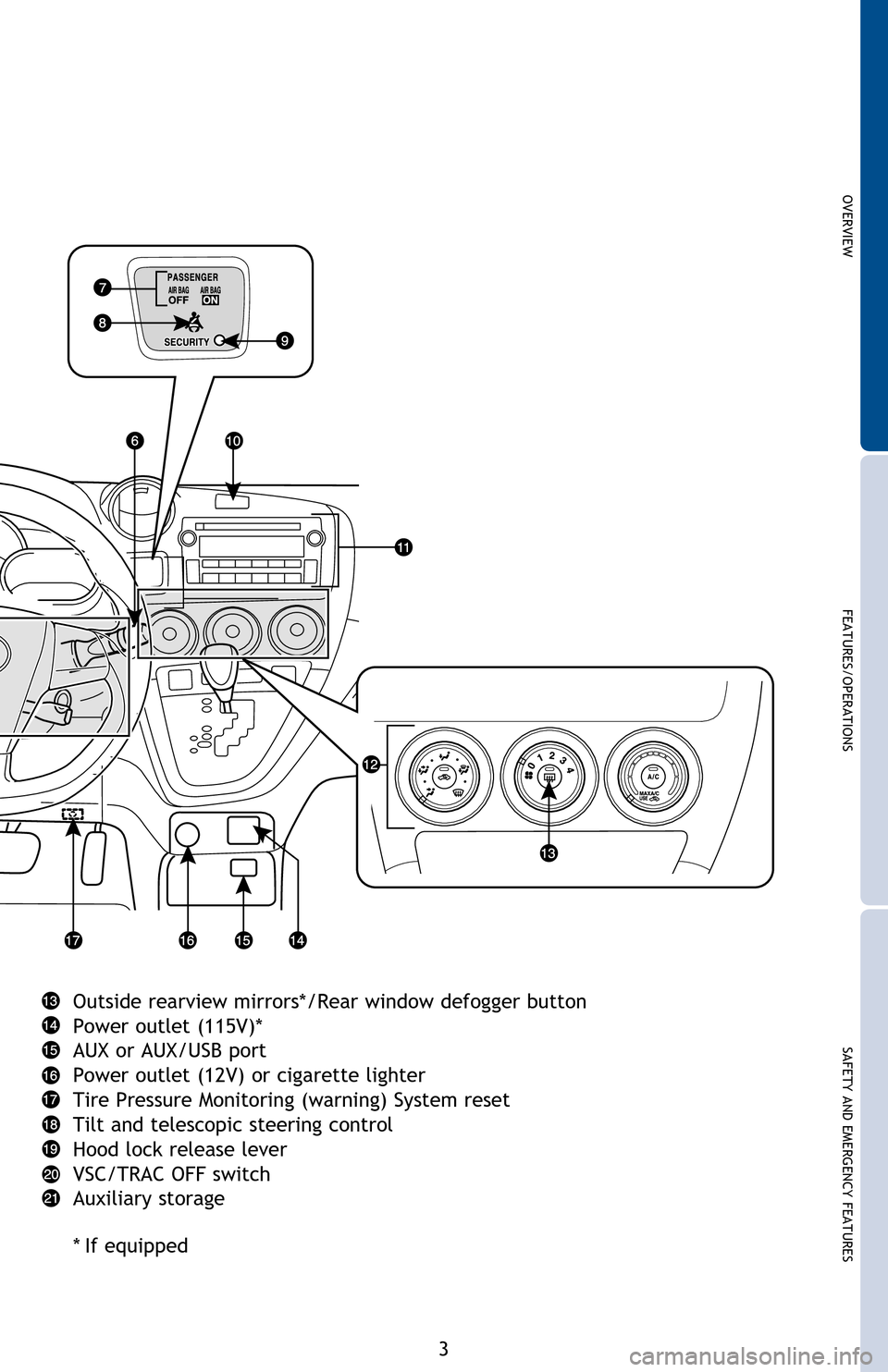
OVERVIEW
FEATURES/OPERATIONS
SAFETY AND EMERGENCY FEATURES
3
Steering wheel audio controls
Ignition switch
Cruise control*
Power outside rearview mirror control
Headlight, turn signal and front fog light*
controls
Wiper and washer controls
“AIR BAG ON” and “AIR BAG OFF” indicator
Front passenger seat belt reminder light
Engine immobilizer indicator
Emergency flasher button
Audio system
Air Conditioning controls
Outside rearview mirrors*/Rear window defogger button
Power outlet (115V)*
AUX or AUX/USB port
Power outlet (12V) or cigarette lighter
Tire Pressure Monitoring (warning) System reset
Tilt and telescopic steering control
Hood lock release lever
VSC/TRAC OFF switch
Auxiliary storage
*
If equipped
126923_2013Matrix.indd 37/21/12 1:36 AM
Page 6 of 28
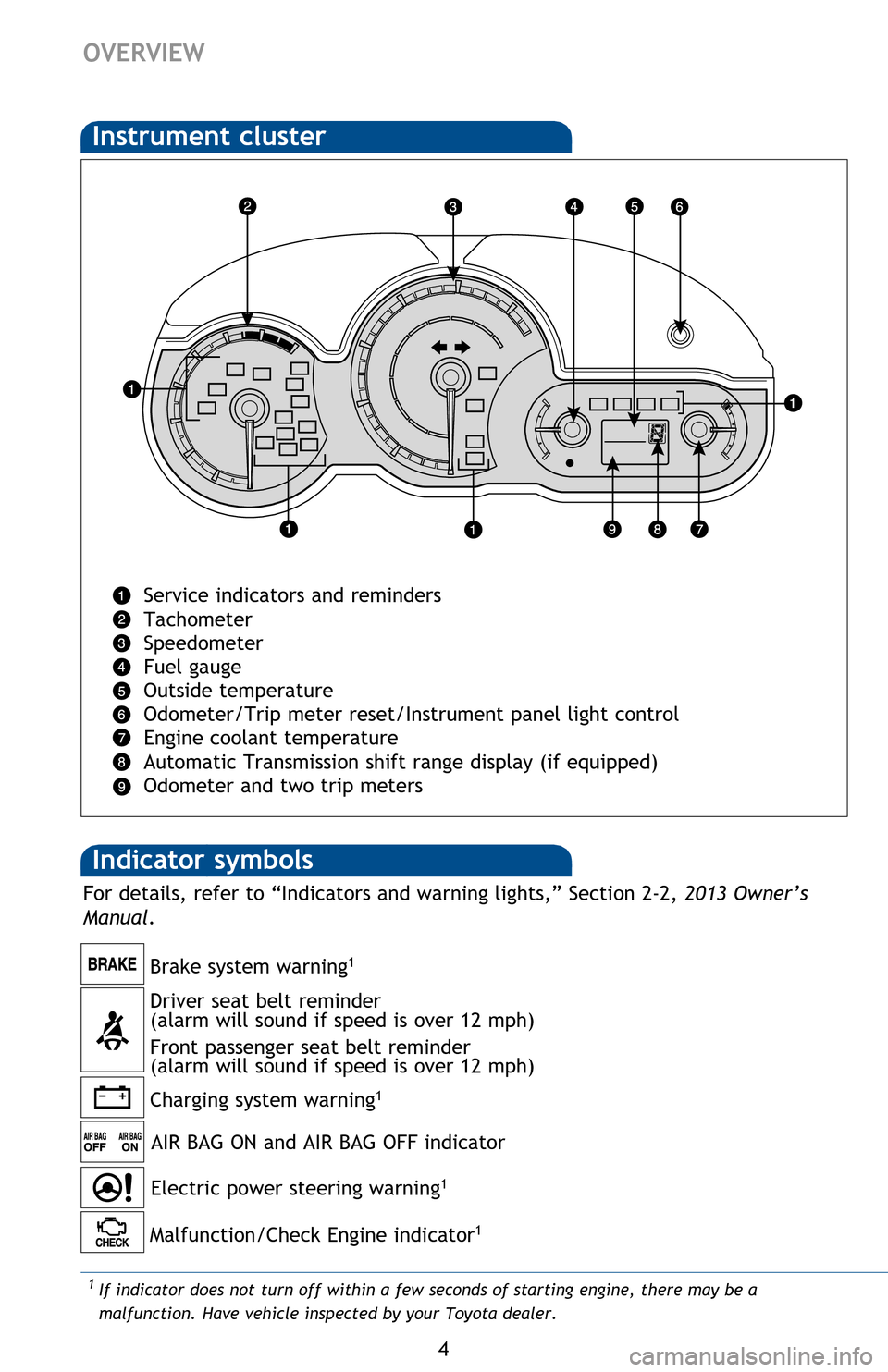
4
OVERVIEW
1 If indicator does not turn off within a few seconds of starting engine, there may be a
malfunction. Have vehicle inspected by your Toyota dealer.
Indicator symbols
Instrument cluster
Service indicators and reminders
Tachometer
Speedometer
Fuel gauge
Outside temperature
Odometer/Trip meter reset/Instrument panel light control
Engine coolant temperature
Automatic Transmission shift range display (if equipped)
Odometer and two trip meters
Charging system warning1
Brake system warning1
AIR BAG ON and AIR BAG OFF indicator
Driver seat belt reminder
(alarm will sound if speed is over 12 mph)
Front passenger seat belt reminder
(alarm will sound if speed is over 12 mph)
Malfunction/Check Engine indicator1
For details, refer to “Indicators and warning lights,” Section 2-2, 2013 Owner’s
Manual .
Electric power steering warning1
2 If this light flashes, refer to “Cruise control,” Section 2-4, 2013 Owner’s Manual.
126923_2013Matrix.indd 47/21/12 1:36 AM
Page 12 of 28
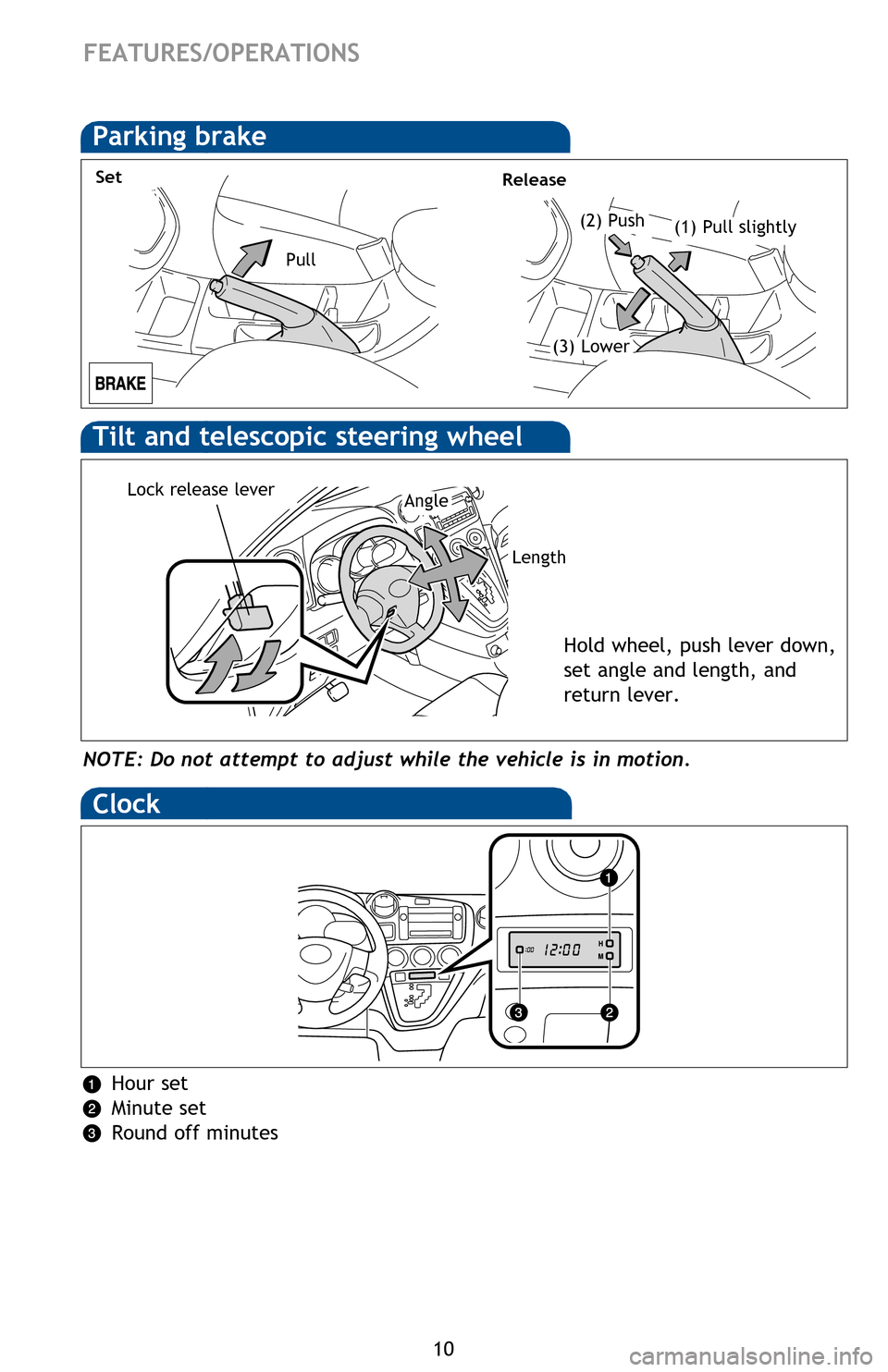
10
FEATURES/OPERATIONS
Parking brake
(2) Push
SetRelease
(1) Pull slightly
(3) Lower
Pull
NOTE: Do not attempt to adjust while the vehicle is in motion.
Tilt and telescopic steering wheel
Lock release leverAngle
Length
Hold wheel, push lever down,
set angle and length, and
return lever.
Clock
Hour set
Minute set
Round off minutes
Lights & turn signals
Turn signals
Headlights
Front fog lights (if equipped)
Daytime Running Light system (DRL) Headlights turn on automatically upon
starting engine.
Front fog lights come on only when the headlights are on low beam.
126923_2013Matrix.indd 107/21/12 1:37 AM
Page 16 of 28
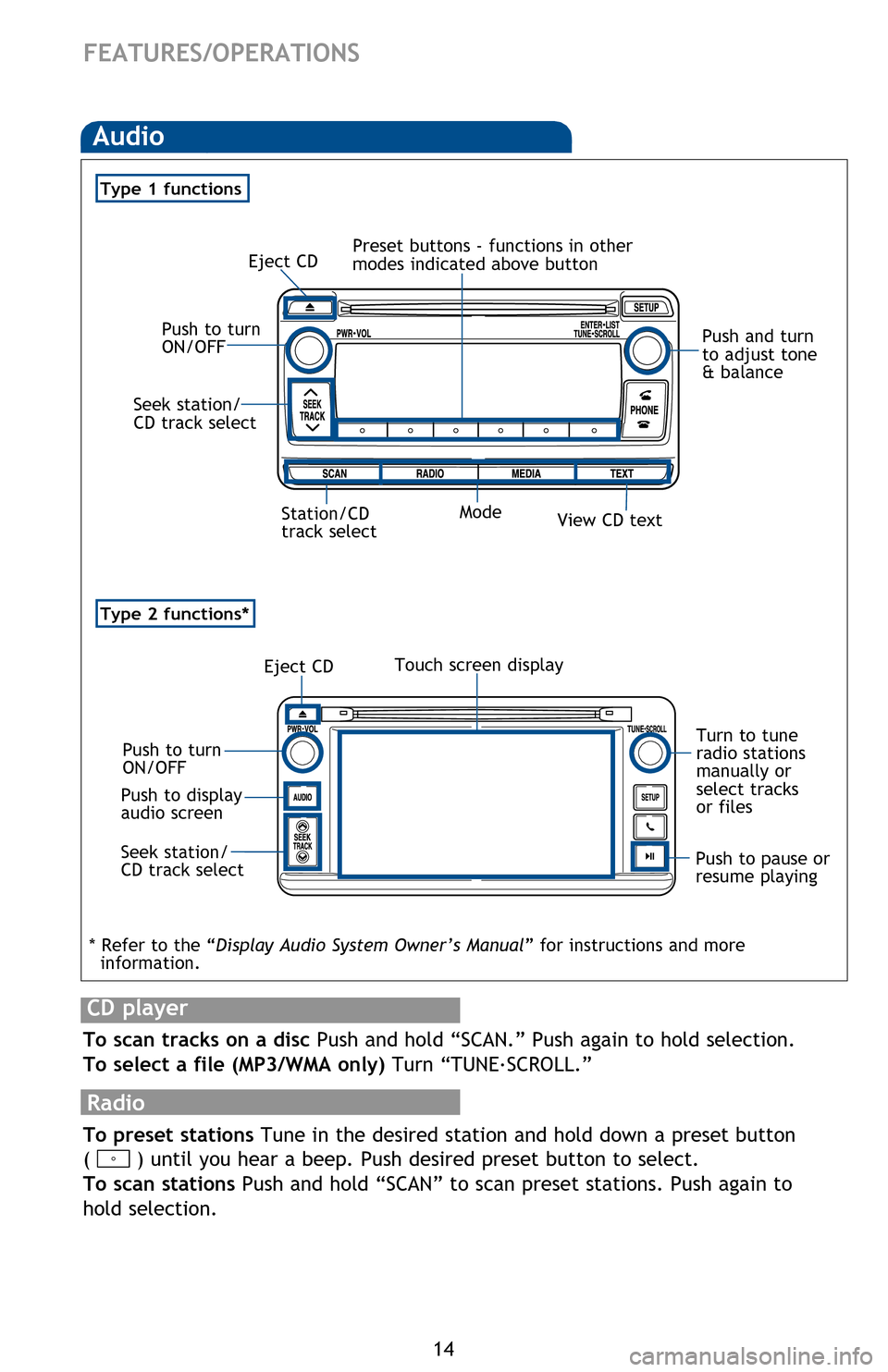
14
FEATURES/OPERATIONS
Audio
“ ”
Use to search within the selected audio medium (radio, CD, iPod®, etc.).
“MODE”
Push
to
turn
audio
ON
and
to
select
an
audio
mode.
Push
and
hold to turn the
audio
system
OFF.
AUX port or USB/AUX port
Steering wheel switches
Type 1 functions
AUX port
By
inserting a mini plug into the AUX port, you can listen to music from a portable
audio
device through the vehicle’s speaker system while in AUX mode.
USB
port (if equipped)
By
connecting a USB-compatible portable audio device or USB memory to the
USB
port, you can listen to music from the portable audio device or USB memory
through
the vehicle’s speaker system while in USB mode.
Radio
To preset stations Tune in the desired station and hold down a preset button
(
) until you hear a beep. Push desired preset button to select.
To
scan stations Push and hold “SCAN” to scan preset stations. Push again to
hold
selection.
CD player
To scan tracks on a disc Push and hold “SCAN.” Push again to hold selection.
To
select a file (MP3/WMA only) Turn “TUNE .
SCROLL.”
Push to turn
ON/OFFPush and turn
to
adjust tone
&
balance
Seek
station/
CD
track
select
Eject CD Preset buttons - functions in other
modes indicated above button
Station/CD
track
selectModeView CD text
Touch
screen
display
Turn to tune
radio stations
manually or
select tracks
or files
Eject
CD
Push
to
turn
ON/OFF
Seek
station/
CD
track
select
Push to pause or
resume
playing
* Refer to the “ Display Audio System Owner’s Manual ” for instructions and more
information. Push to display
audio screen
Type
2 functions*
126923_2013Matrix.indd 147/21/12 1:37 AM
Page 17 of 28
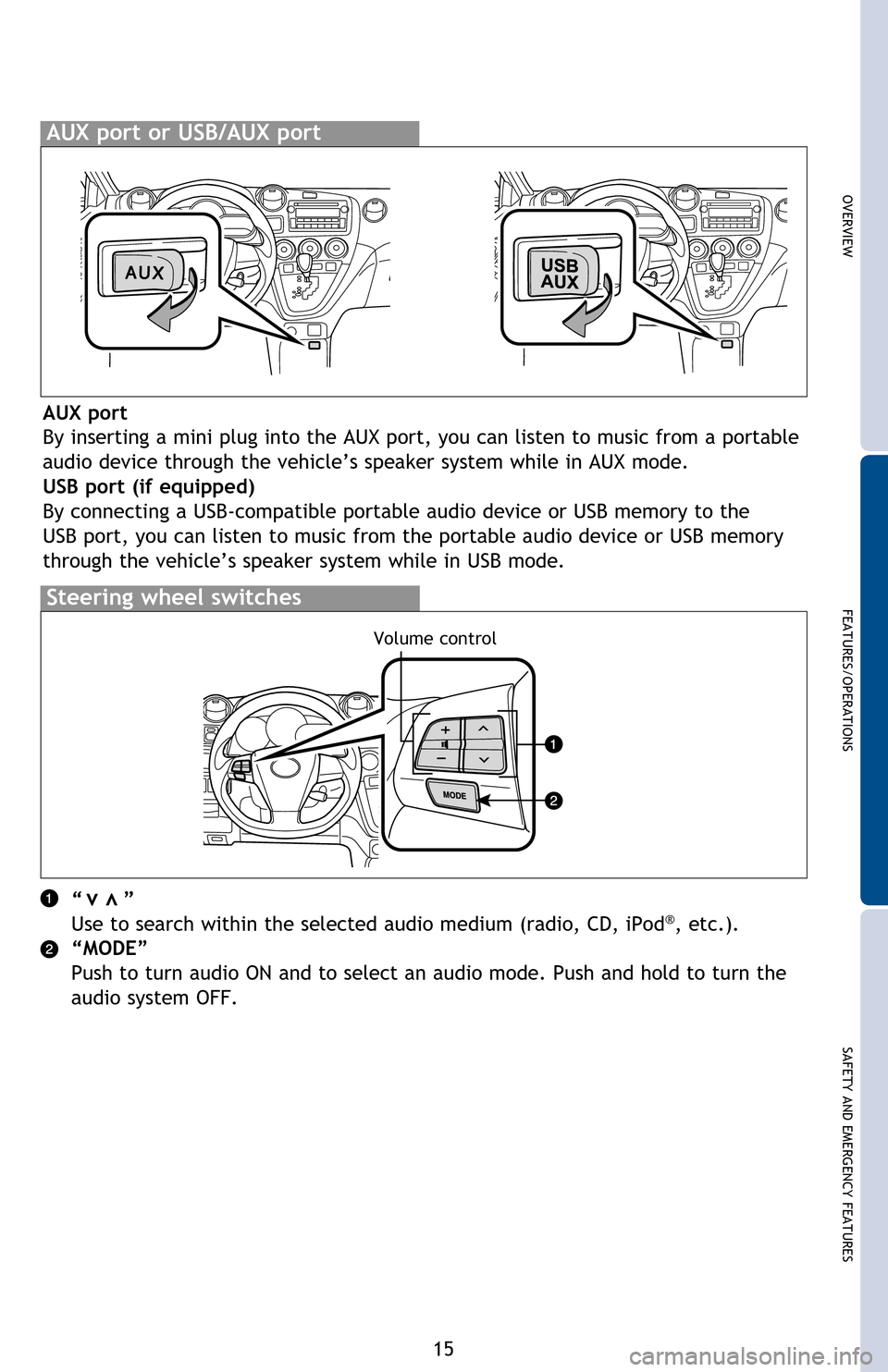
OVERVIEW
FEATURES/OPERATIONS
SAFETY AND EMERGENCY FEATURES
15
“ ”
Use to search within the selected audio medium (radio, CD, iPod®, etc.).
“MODE”
Push to turn audio ON and to select an audio mode. Push and hold to turn the
audio system OFF.
vv
AUX port or USB/AUX port
Steering wheel switches
AUX port
By inserting a mini plug into the AUX port, you can listen to music from a portable
audio device through the vehicle’s speaker system while in AUX mode.
USB port (if equipped)
By connecting a USB-compatible portable audio device or USB memory to the
USB port, you can listen to music from the portable audio device or USB memory
through the vehicle’s speaker system while in USB mode.
To preset stations Tune in the desired station and hold down a preset button
(
) until you hear a beep. Push desired preset button to select.
To scan stations Push and hold “SCAN” to scan preset stations. Push again to
hold selection.
To scan tracks on a disc Push and hold “SCAN.” Push again to hold selection.
To select a file (MP3/WMA only) Turn “TUNE .
SCROLL.”
Push and turn
to adjust tone
& balance
Turn to tune
radio stations
manually or
select tracks
or files
Push to pause or
resume playing
* Refer to the “Display Audio System Owner’s Manual ” for instructions and more
information.
Volume control
126923_2013Matrix.indd 157/21/12 1:37 AM
Page 20 of 28
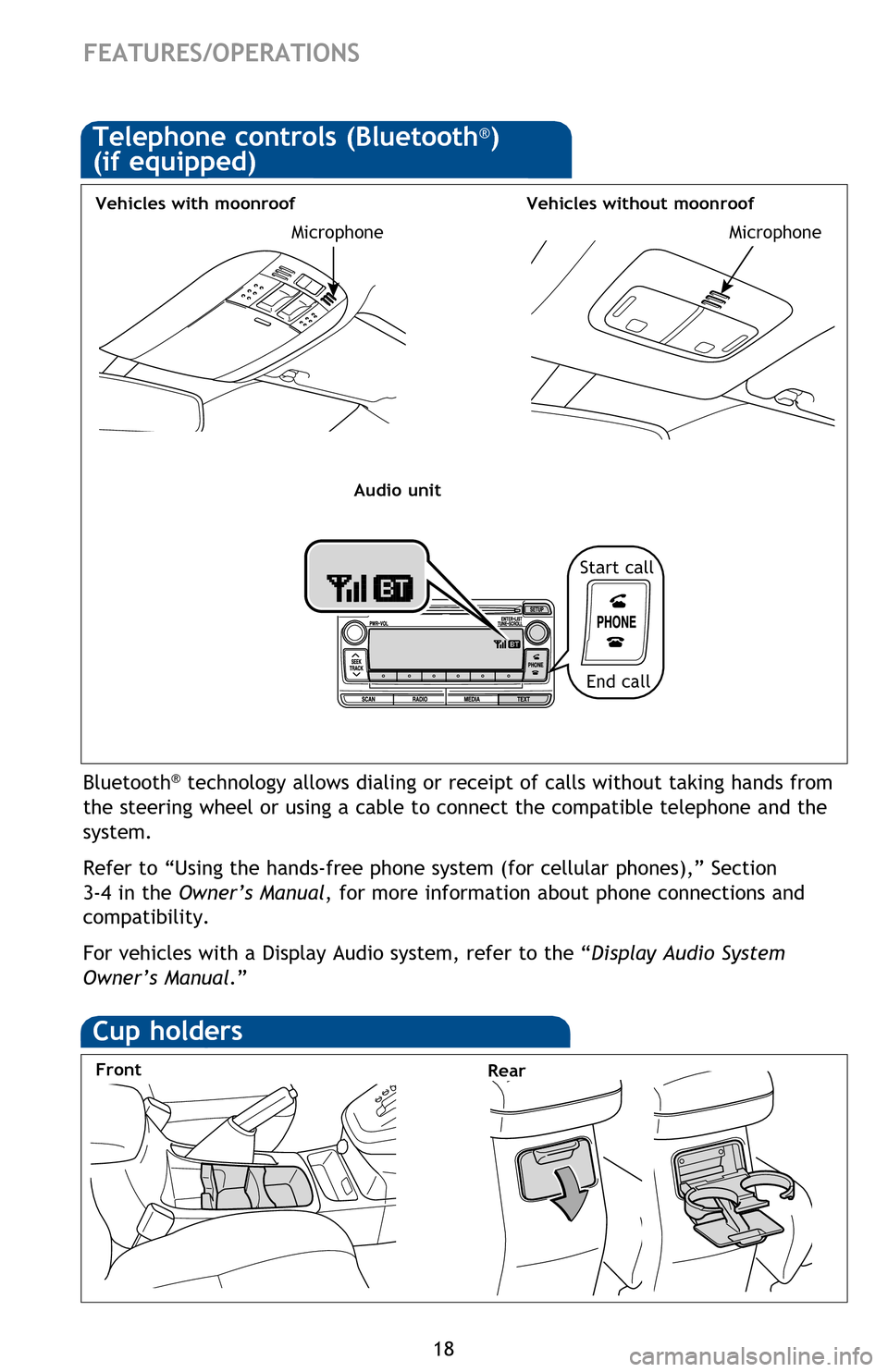
18
FEATURES/OPERATIONS
Power outlet-12V DC (if equipped)
Power outlet-115V AC (if equipped)
Designed for 12V car accessories.
The ignition switch must be in the “ACC” or “ON” position.
The ignition switch must be in the “ON” position.
Bluetooth® technology allows dialing or receipt of calls without taking hands from
the steering wheel or using a cable to connect the compatible telephone and the
system.
Refer to “Using the hands-free phone system (for cellular phones),” Section
3-4 in the Owner’s Manual , for more information about phone connections and
compatibility.
For vehicles with a Display Audio system, refer to the “Display Audio System
Owner’s Manual. ”
Telephone controls (Bluetooth®)
(if equipped)
Vehicles without moonroofVehicles with moonroof
Cup holders
FrontRear
Bottle holders
Front
MicrophoneMicrophone
Audio unit
End call
Start call
126923_2013Matrix.indd 187/21/12 1:37 AM
Page 21 of 28
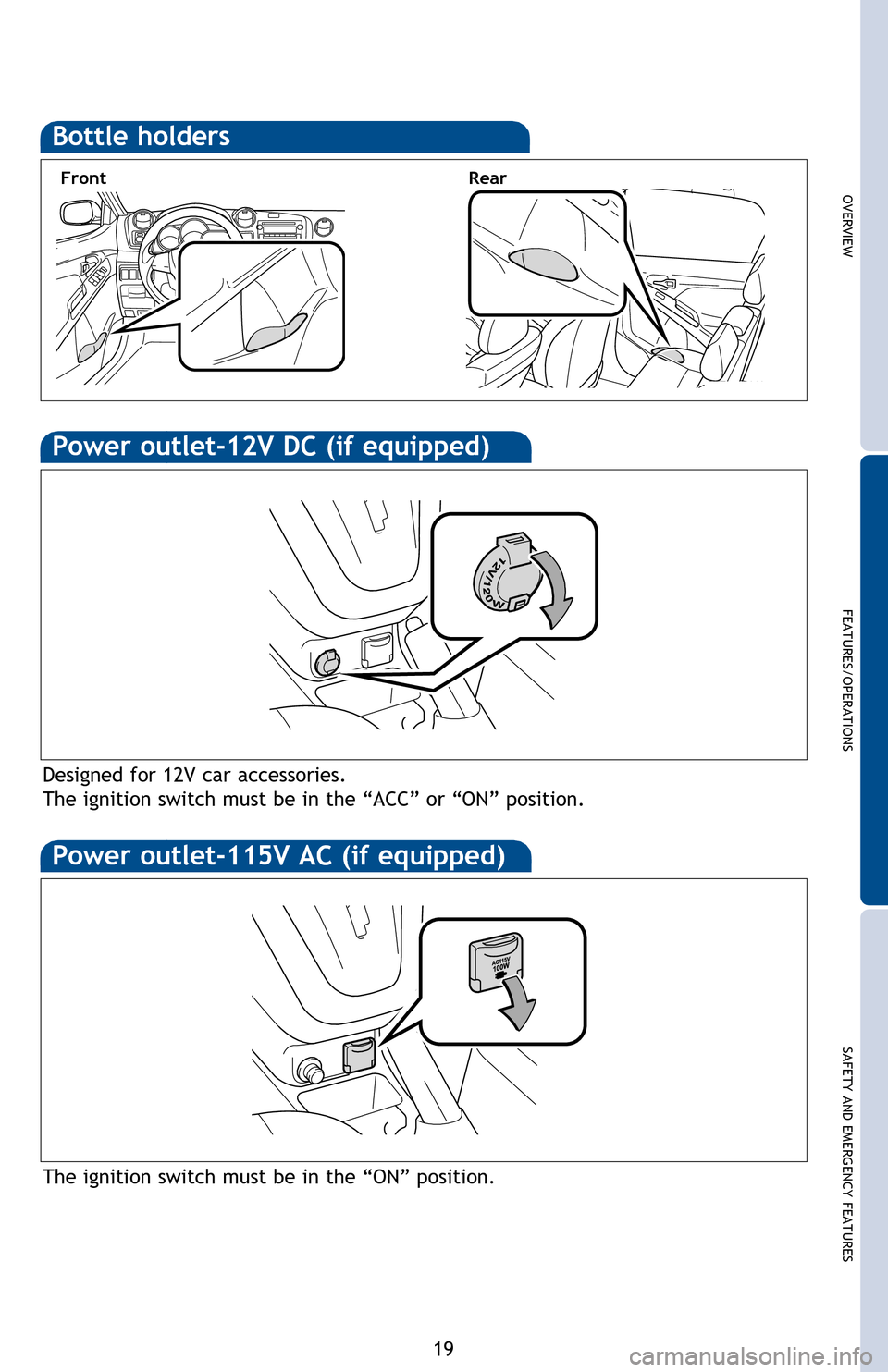
OVERVIEW
FEATURES/OPERATIONS
SAFETY AND EMERGENCY FEATURES
19
Power outlet-12V DC (if equipped)
Power outlet-115V AC (if equipped)
Designed for 12V car accessories.
The ignition switch must be in the “ACC” or “ON” position.
The ignition switch must be in the “ON” position.
Bluetooth® technology allows dialing or receipt of calls without taking hands from
the steering wheel or using a cable to connect the compatible telephone and the
system.
Refer to “Using the hands-free phone system (for cellular phones),” Section
3-4 in the Owner’s Manual , for more information about phone connections and
compatibility.
For vehicles with a Display Audio system, refer to the “Display Audio System
Owner’s Manual. ”
Vehicles without moonroof
Bottle holders
Front Rear
Microphone
126923_2013Matrix.indd 197/21/12 1:37 AM
Page 24 of 28
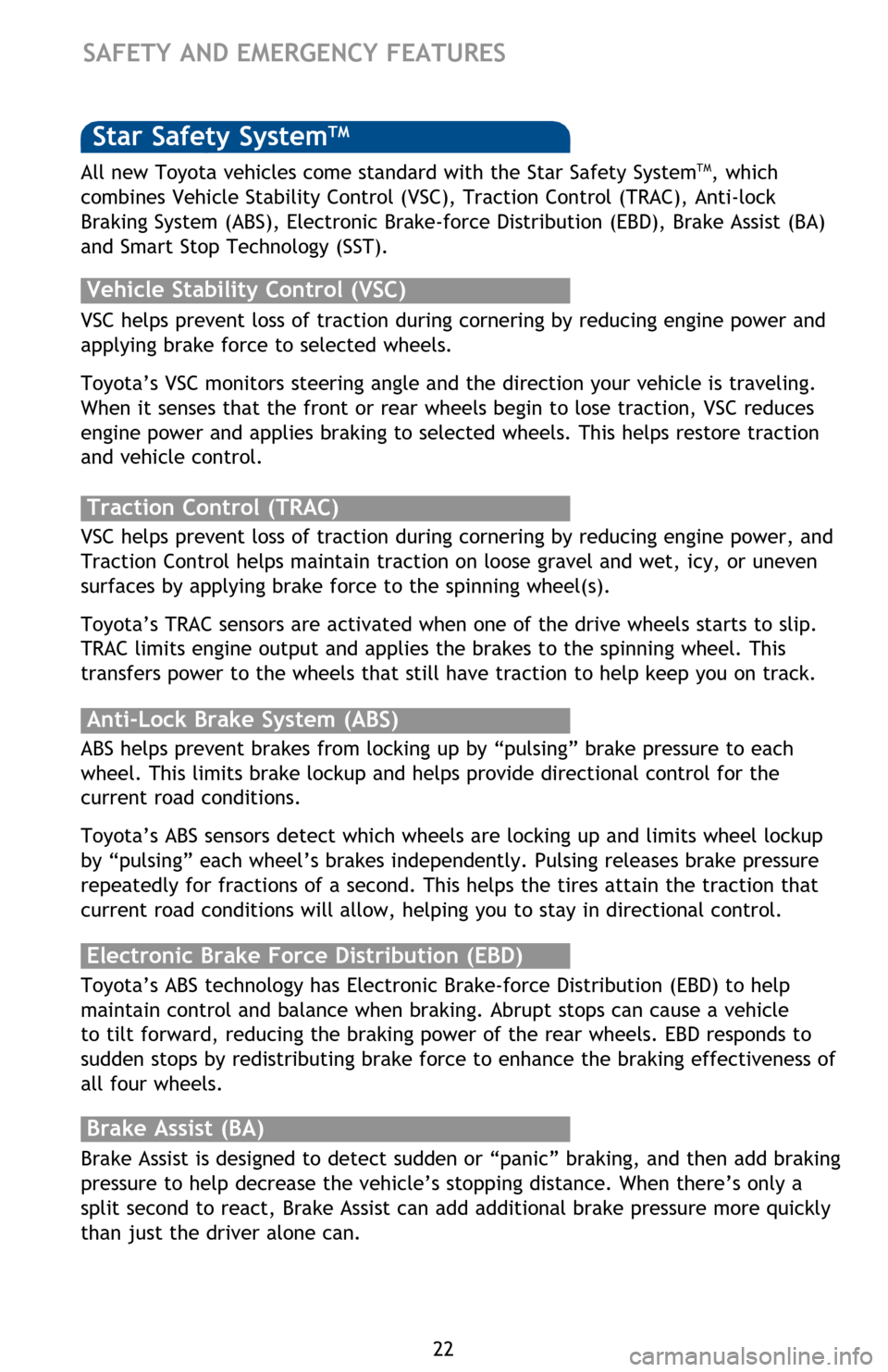
22
Star Safety SystemTM
VSC helps prevent loss of traction during cornering by reducing engine power and
applying brake force to selected wheels.
Toyota’s VSC monitors steering angle and the direction your vehicle is traveling.
When it senses that the front or rear wheels begin to lose traction, VSC reduces
engine power and applies braking to selected wheels. This helps restore traction
and vehicle control.
Vehicle Stability Control (VSC)
Anti-Lock Brake System (ABS)
ABS helps prevent brakes from locking up by “pulsing” brake pressure to each
wheel. This limits brake lockup and helps provide directional control for the
current road conditions.
Toyota’s ABS sensors detect which wheels are locking up and limits wheel lockup
by “pulsing” each wheel’s brakes independently. Pulsing releases brake pressure
repeatedly for fractions of a second. This helps the tires attain the traction that
current road conditions will allow, helping you to stay in directional control.
Brake Assist (BA)
Brake Assist is designed to detect sudden or “panic” braking, and then add braking
pressure to help decrease the vehicle’s stopping distance. When there’s only a
split second to react, Brake Assist can add additional brake pressure more quickly
than just the driver alone can. VSC helps prevent loss of traction during cornering by reducing engine power, and
Traction Control helps maintain traction on loose gravel and wet, icy, or uneven
surfaces by applying brake force to the spinning wheel(s).
Toyota’s TRAC sensors are activated when one of the drive wheels starts to slip.
TRAC limits engine output and applies the brakes to the spinning wheel. This
transfers power to the wheels that still have traction to help keep you on track.
Traction Control (TRAC)
Electronic Brake Force Distribution (EBD)
Toyota’s ABS technology has Electronic Brake-force Distribution (EBD) to help
maintain control and balance when braking. Abrupt stops can cause a vehicle
to tilt forward, reducing the braking power of the rear wheels. EBD responds to
sudden stops by redistributing brake force to enhance the braking effectiveness of
all four wheels.
There are two types of Toyota floor mats: carpeted and all-weather. Each vehicle
has model-specific floor mats. Installation is easy.
To keep your floor mat properly positioned, follow these steps:
• Only use floor mats designed for your specific model.
• Use only one floor mat at a time, using the retaining hooks to keep the mat in
place.
• Install floor mats right side up.
Floor mat installation
SAFETY AND EMERGENCY FEATURES
All new Toyota vehicles come standard with the Star Safety SystemTM, which
combines Vehicle Stability Control (VSC), Traction Control (TRAC), Anti-lock
Braking System (ABS), Electronic Brake-force Distribution (EBD), Brake Assist (BA)
and Smart Stop Technology (SST).Smart Stop Technology automatically reduces engine power when the accelerator
and brake pedals are pressed simultaneously under certain conditions.
SST engages when the accelerator is depressed first and the brakes are applied
firmly for longer than one-half second at speeds greater than five miles per hour.
SST doesn’t engage if the brake pedal is depressed before the accelerator pedal,
allowing vehicles to start on a steep hill and safely accelerate without rolling
backward.
Smart Stop Technology (SST)
126923_2013Matrix.indd 227/21/12 1:37 AM